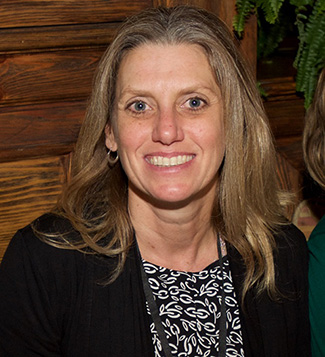
Leslie Wilson
After a career spent producing live events for television, working on Auschwitz: The Past is Present allowed Leslie Wilson to return to her early passion for history in what she calls a life-changing experience.
Wilson was brought on last year as USC Shoah Foundation’s production coordinator for Auschwitz: The Past is Present, a multi-faceted program that commemorated the 70th anniversary of the liberation of Auschwitz in January 2015. Wilson, who has a background producing live events including the Oscars, Superbowl halftime shows and political events, helped coordinate the re-release of Schindler’s List, the partnership with World Jewish Congress that brought 100 survivors to Poland for the commemoration at Auschwitz-Birkenau State Museum – and, somewhat unexpectedly, she produced the educational film One Day in Auschwitz, which was broadcast on Discovery.
Not surprisingly, Wilson said The Past is Present was unlike anything she’d worked on before. But this was exactly why she was attracted to the project. As an eighth grader, she was fascinated to meet Holocaust survivor Barry Spanjaard, and in college she studied anthropology and was interested in making documentaries. Working with USC Shoah Foundation gave her the opportunity to return to subject matter she hadn’t had the chance to explore.
One Day in Auschwitz was the brainchild of USC Shoah Foundation Executive Director Stephen Smith and survivor Kitty Hart-Moxon, whose testimony is in the Visual History Archive and who is a close friend of Smith. Wilson said Kitty had two conditions for the project: she wanted to tour Auschwitz with two girls who were her age when she was a prisoner of Auschwitz, and she wanted USC Shoah Foundation to produce the documentary so it would be preserved in perpetuity. She had actually been the subject of another educational film Kitty: Return to Auschwitz in 1978 and was somewhat of a “rock star” during the filming, Wilson said, since she was frequently recognized by people who had watched the film in school.
Wilson said that the process of filming One Day in Auschwitz wasn’t like a normal film shoot. The filming was often influenced by Kitty herself; as she walked through Auschwitz with high school students Lydia Hollingsworth and Natalia Smith, she might stop and point something out that she wanted to talk about.
“You’re capturing a slice of life as opposed to scripting something out,” Wilson said. “There was a lot of discovering as we went along.”
The two students walking with Kitty and asking her questions also made the shoot a little more unpredictable for Kitty. Wilson observed that the girls’ questions got Kitty to talk about her experiences differently than she normally does, which seemed to be an interesting challenge for her.
However, Kitty also had specific topics she wanted to discuss. She was adamant that the film include her time in “Canada” – the warehouse where a few prisoners were tasked with sorting all the personal belongings that had been confiscated in Auschwitz – and the “Little White House,” one of the original gas chambers. Neither of these places have been spoken about by survivors much, since most who saw them were murdered.
Being in Auschwitz with Kitty and hearing her talk about the horrific things she had experienced and witnessed there 70 years ago affected Wilson deeply. She found that she could not remain detached from the subject matter like she can on other projects, focused only on the practicalities of getting the job done.
“You’re standing in Birkenau next to the crematorium listening to her talk, and there’s no way you could not have that affect you,” Wilson said. She said the experience has “changed her life,” and inspired her to spend more time with family and focus on what’s most important.
Since working on The Past is Present with USC Shoah Foundation, Wilson has been stunned to hear from so many friends and acquaintances whom she had no idea had personal connections to the Holocaust, like her landlord of 18 years who told her one whole side of his family was killed in Auschwitz. This has proven how important it is for material like this to be shown around the world.
“People are interested. People want to know. People don’t want it to happen again,” she said. “A lot of people think this story is really important.”